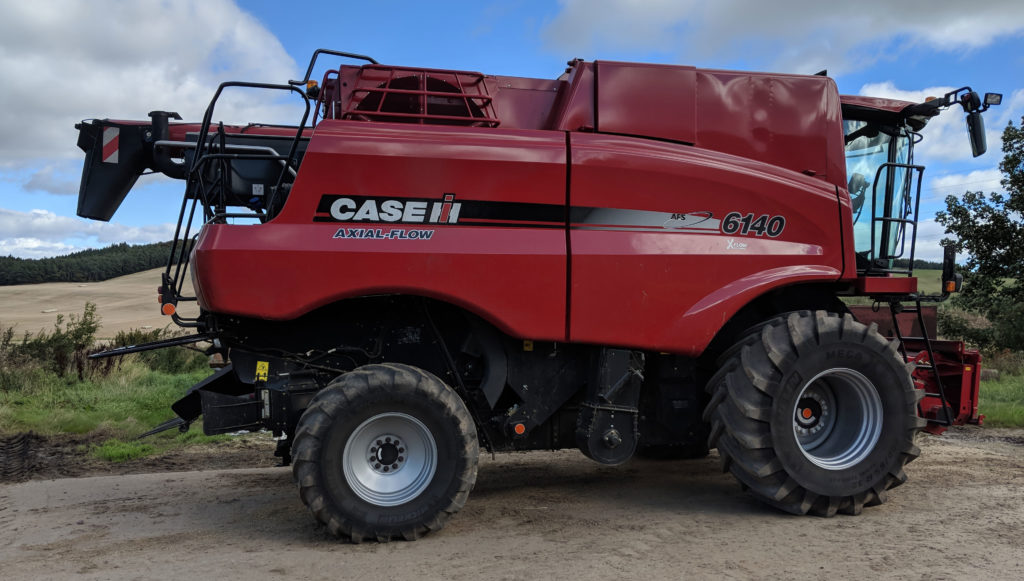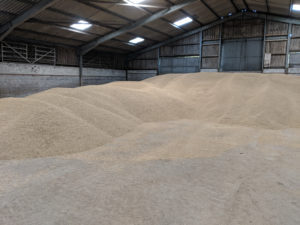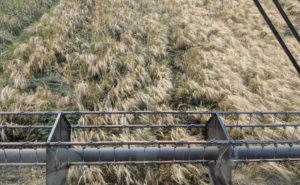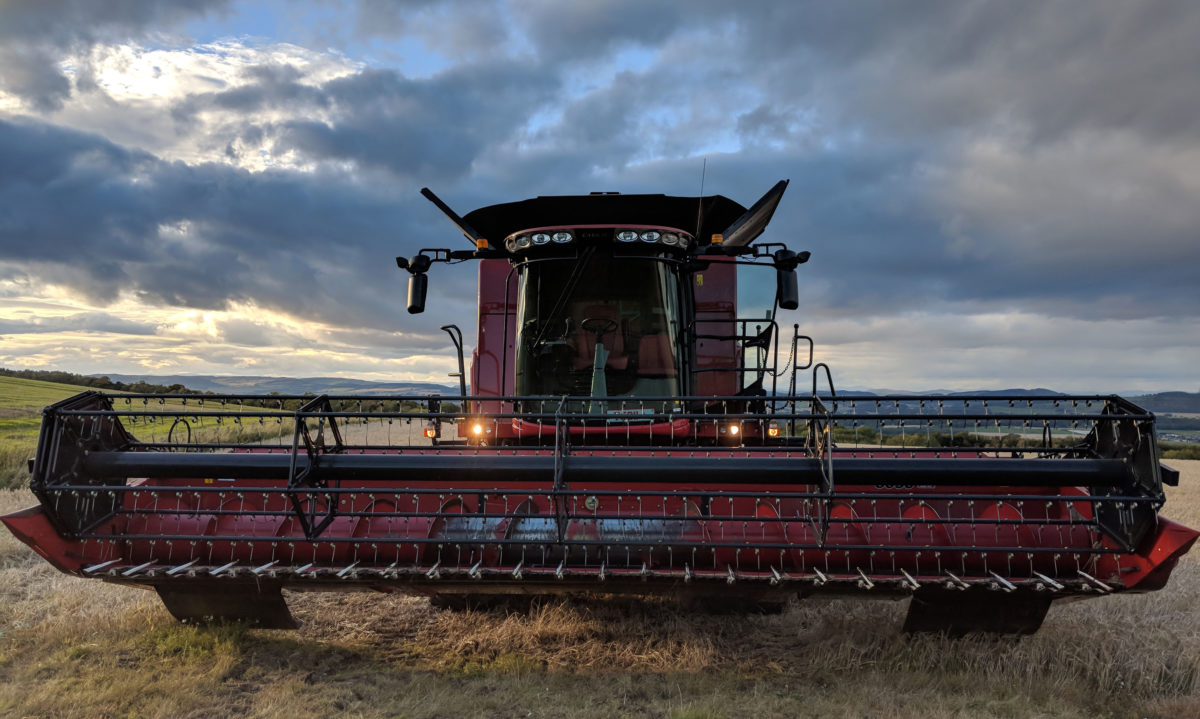“One more harvest done, one less harvest to do…” Harvest finished on the 29th of September this year, one of the later finishes we’ve had for a while. It pretty much followed the pattern of the year so far, in that it was totally weird. We had an early start, and it looked like we were going to have an early harvest, as the crops were ripening fast with it being so dry and warm. Then the weather sort of half broke around the middle of August, and all the crops from the farm up the hill just stopped dead in their tracks. It was almost as if they got the rain, and stopped to take a good long drink before finishing off their ripening. It meant we had a long pause in the middle, and much frustration as we were wanting to get on and get it done.
Having said that, the pauses did give us a chance to get other things done, more of which later.
Demonstrator Combine
In my posts last year, I mentioned that our combine was a bit old, and probably needing replaced. Because we had repair work to do at the grain dryer this year I put on hold plans to change the combine, and our one has successfully negotiated another harvest without too much bother. However, it was very much on my mind that a major or serious breakdown might not be far away. Last year I had a wee shot of a New Holland combine and I was very impressed. Our ‘breed’ of combine is Case, and it is a totally different design from other makes, so I was quite glad when the local Case dealer, J. Low Agri Services, offered me a demonstration of a new Case combine. The feature picture of the post shows it in full work readiness, and the picture below shows it parked up in the farmyard where all the neighbours could clearly see it 🙂

This combine is the mid range model, but is still far bigger than ours. The header (the bit that does the cutting) is 25 feet (over 7 metres) wide, where ours is just 20 feet (over 6 metres). The extra width means you can cut more – in theory, but as I found out it does have its problems. A header that size is fine if you have big fields that are reasonably level. They don’t need to be flat, as the header ‘floats’ – ie it follows the contours, but we have some smaller fields, and fields with steep gulleys. This meant that the ends of the header could be hitting the ground, where the middle of it was sitting above the crop.
However, overall I was impressed, and it was a pleasure to drive and to use. I wasn’t impressed enough to ask for the price though. That will have to wait until later on in the winter.
Far Flung Outpost of the Empire
The main crop we grow at Cults Farm is malting barley. This is all sold to East of Scotland Farmers, a farmer owned co-operative who are based in Coupar Angus about 30 miles away from us. The way it works is they operate a grain pool. Basically their growers supply the malting barley to EoSF, who dry it down and store it. They then market it to the Maltsters over the winter. The price you get paid is the average of what they manage to sell it for. You get paid in installments through the winter, the first one usually coming in early October, so they want to get it all in by early September at the latest. This means that grain is going away almost as fast as it is coming off the combine – usually.
Unfortunately it didn’t quite work out that way this year for a number of reasons, and we found ourselves scrabbling about a bit to try and fit grain in as we harvested it. The first problem we have is that we are one of the furthest away members of the co-op, so organising haulage is a bit more challenging for them.
Secondly, the weather meant that everyone was cutting very ripe spring barley at the same time, and they were flooded out with malting barley coming in (as were the hauliers trying to lift it all).
Thirdly, we had agreed to store some of our barley until the end of the season for them, as this was a trial batch of a new variety (Sassy) for one of their maltster clients. Knowing this we planned our storage space out on the basis that the other variety we grew (Laureate) would be lifted fairly quickly after we cut it, but of course this didn’t happen.
Now, we have plenty storage space – we can easily store all our harvest in various sheds if we have to – but this year the available space was all in the wrong places. Thankfully the bulk of the Laureate was cut fairly dry so it didn’t start to spoil in the shed, but it was a bit of a struggle for a while.

The other consequence of this was that we loaded over 700 tonnes of barley in just over 2 weeks – while we were desperately trying to get harvest finished. To say things were hectic is an understatement!
However, we got there. We were patient and talked regularly to the transport manager at EoSF, so that we (and he) knew what stages we were at. We are very grateful to Malcolm, Colin and Robin for their efforts in what was a tricky year.
Barley Quality and Yields
Every year has its own problems as far as grain quality is concerned. Two years ago our grain nitrogen levels were on the high side. Last year the grain skinned very easily (the husk of the barley comes away from the seed too easily). This year there were two problems: nitrogen levels and germination (I talk about ‘nitrogen’, but really I mean compounds containing nitrogen – proteins).
The nitrogen levels were high because the year has been dry. This has meant that the crop yield is well back, so any nitrogen the plant has taken up has gone into fewer grains that it normally would – so the nitrogen content of the grain was higher. Nitrogen levels were high across the country, and yields were down, so the maltsters agreed to lift their tolerances for nitrogen from 1.65 to 1.7. This made a huge difference.
Germination levels are extremely important in malting barley. The food store in a barley seed is starch. For brewers and distillers to make us of this it has to be turned in to sugar, so it can turn to alcohol in the fermentation process. The way this happens is to allow the seed to start to grow, so that it gets as far as turning the starch into sugar, and then stopping it. Obviously if the seed is dead, it won’t grow. Germination levels for malting barley have to be 96% or higher.
As I have said elsewhere, Cults Farm has early ground down the bottom of the hill, and later ground up the top. We had no bother with germination on the early ground, but as harvest progressed (and we got some rain), levels started to fall. Thankfully we only had one load rejected for germination (92%), and to be honest we weren’t that surprised when we heard about it.
Harvest Technology
Harvest technology has come on leaps and bounds since I came home to farm in the early 1990’s. You can get GPS that steers the combine, and maps the yield in a field (though we don’t have either), the combine can set itself, and follow the contours of the ground. However, perhaps the most essential part of the Cults Farm combine driver’s toolkit are a pair of Automagic Crop Ripening (ACR) Goggles. When you get close to the end of harvest and you are impatient for a crop to ripen off, simply put on a pair of ACR goggles and the crop appears ripe, allowing you to carry on harvesting.
These were originally pioneered by a neighbour of ours (the first version being known as ‘Ainslie Specs’), but we have developed and refined the design to include the standard ACR goggles, and the deluxe version. This has extra enhancements such as Instant Weather Improver (IWI) which makes clouds and rainfall invisible giving the impression of a sunny harvest day, and the optional Crop Yield Enhancer (CYE) which gives the impression the crop is actually quite good. This can turn the impatience of finishing a late harvest into a pleasant experience.
The below pictures show the view the combine driver would normally see of an unripe crop, and then the same crop viewed with deluxe ACR goggles with IWI and CYE turned on.


And Finally…

Harvest is a very stressful time of the year and we are very grateful to the people who help out, and generally help things to go smoothly. In no particular order:
Brian, David, & Cameron for driving combines, tractors, watching grain dryers, and helping to keep myself and Dad sane.
Stuart from Sellars for keeping the combine going.
Charlie Pryde for keeping the dryer going.
Chrystal Petroleum for making sure we had plenty fuel for grain dryers, combines & tractors.
Sally and Susie for keeping the combine driver company on long harvest days. They are too old to jump out from the cab to chase rabbits now, but that doesn’t stop them turning somersaults in the cab when they see one!

